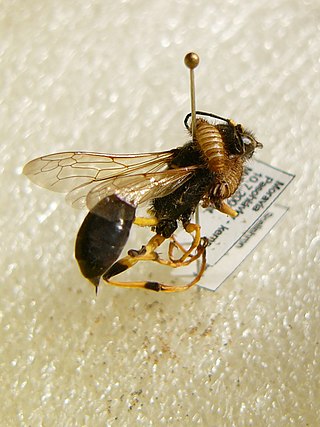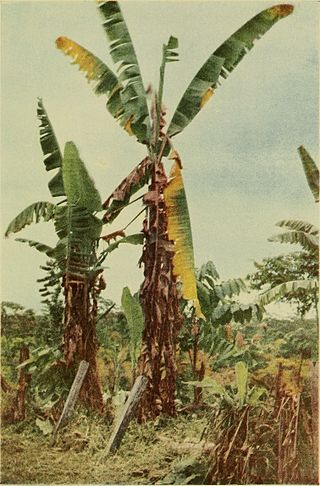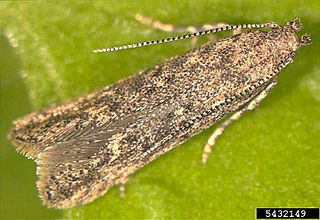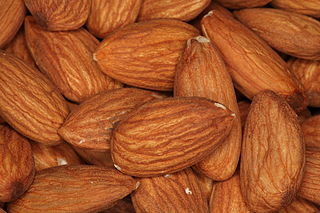
A banana is an elongated, edible fruit – botanically a berry – produced by several kinds of large herbaceous flowering plants in the genus Musa. In some countries, bananas used for cooking may be called "plantains", distinguishing them from dessert bananas. The fruit is variable in size, color, and firmness, but is usually elongated and curved, with soft flesh rich in starch covered with a rind, which may be green, yellow, red, purple, or brown when ripe. The fruits grow upward in clusters near the top of the plant. Almost all modern edible seedless (parthenocarp) bananas come from two wild species – Musa acuminata and Musa balbisiana. The scientific names of most cultivated bananas are Musa acuminata, Musa balbisiana, and Musa × paradisiaca for the hybrid Musa acuminata × M. balbisiana, depending on their genomic constitution. The old scientific name for this hybrid, Musa sapientum, is no longer used.

A pest is any organism harmful to humans or human concerns. The term is particularly used for creatures that damage crops, livestock, and forestry or cause a nuisance to people, especially in their homes. Humans have modified the environment for their own purposes and are intolerant of other creatures occupying the same space when their activities impact adversely on human objectives. Thus, an elephant is unobjectionable in its natural habitat but a pest when it tramples crops.

Mangosteen, also known as the purple mangosteen, is a tropical evergreen tree with edible fruit native to tropical lands surrounding the Indian Ocean. Its origin is uncertain due to widespread prehistoric cultivation. It grows mainly in Southeast Asia, southwest India and other tropical areas such as Colombia and Puerto Rico, where the tree has been introduced.
Fungicides are pesticides used to kill parasitic fungi or their spores. Fungi can cause serious damage in agriculture, resulting in critical losses of yield, quality, and profit. Fungicides are used both in agriculture and to fight fungal infections in animals. Fungicides are also used to control oomycetes, which are not taxonomically/genetically fungi, although sharing similar methods of infecting plants. Fungicides can either be contact, translaminar or systemic. Contact fungicides are not taken up into the plant tissue and protect only the plant where the spray is deposited. Translaminar fungicides redistribute the fungicide from the upper, sprayed leaf surface to the lower, unsprayed surface. Systemic fungicides are taken up and redistributed through the xylem vessels. Few fungicides move to all parts of a plant. Some are locally systemic, and some move upward. Most fungicides that can be bought retail are sold in liquid form, the active ingredient being present at 0.08% in weaker concentrates, and as high as 0.5% for more potent fungicides. Fungicides in powdered form are usually around 90% sulfur.

Black sigatoka is a leaf-spot disease of banana plants caused by the ascomycete fungus Mycosphaerella fijiensis (Morelet), also known as black leaf streak. It was discovered in 1963 and named for its similarities with yellow Sigatoka, which is caused by Mycosphaerella musicola (Mulder), which was itself named after the Sigatoka Valley in Fiji. In the same valley an outbreak of this disease reached epidemic proportions from 1912 to 1923.

Panama disease is a plant disease that infects banana plants. It is a wilting disease caused by the fungus Fusarium oxysporum f. sp. cubense (Foc). The pathogen is resistant to fungicides and its control is limited to phytosanitary measures.

Ralstonia solanacearum is an aerobic non-spore-forming, Gram-negative, plant pathogenic bacterium. R. solanacearum is soil-borne and motile with a polar flagellar tuft. It colonises the xylem, causing bacterial wilt in a very wide range of potential host plants. It is known as Granville wilt when it occurs in tobacco. Bacterial wilts of tomato, pepper, eggplant, and Irish potato caused by R. solanacearum were among the first diseases that Erwin Frink Smith proved to be caused by a bacterial pathogen. Because of its devastating lethality, R. solanacearum is now one of the more intensively studied phytopathogenic bacteria, and bacterial wilt of tomato is a model system for investigating mechanisms of pathogenesis. Ralstonia was until recently classified as Pseudomonas, with similarity in most aspects, except that it does not produce fluorescent pigment like Pseudomonas. The genomes from different strains vary from 5.5 Mb up to 6 Mb, roughly being 3.5 Mb of a chromosome and 2 Mb of a megaplasmid. While the strain GMI1000 was one of the first phytopathogenic bacteria to have its genome completed, the strain UY031 was the first R. solanacearum to have its methylome reported. Within the R. solanacearum species complex, the four major monophyletic clusters of strains are termed phylotypes, that are geographically distinct: phylotypes I-IV are found in Asia, the Americas, Africa, and Oceania, respectively.

Cochliobolus carbonum is one of more than 40 species of filamentous ascomycetes belonging to the genus Cochliobolus. This pathogen has a worldwide distribution, with reports from Australia, Brazil, Cambodia, Canada, China, Congo, Denmark, Egypt, India, Kenya, New Zealand, Nigeria, Solomon Islands, and the United States. Cochliobolus carbonum is one of the most aggressive members of this genus infecting sorghum, corn and apple. As one of the most devastating pathogens of sweet corn, C. carbonum causes Northern leaf spot and ear rot disease while the asexual stage causes Helminthosporium corn leaf spot. Cochliobolus carbonum is pathogenic to all organs of the corn plant including root, stalk, ear, kernel, and sheath. However, symptoms of infection show distinct manifestations in different plant parts: whole plant - seedling blight affects the whole plant, leaf discoloration and mycelial growth, black fungal spores and lesions appear on inflorescences and glumes, and grain covered with very dark brown to black mycelium which gives a characteristic charcoal appearance due to the production of conidia.

Musa acuminata is a species of banana native to Southern Asia, its range comprising the Indian Subcontinent and Southeast Asia. Many of the modern edible dessert bananas are from this species, although some are hybrids with Musa balbisiana. First cultivated by humans around 10 kya, it is one of the early examples of domesticated plants.

Ensete ventricosum, commonly known as enset or ensete, Ethiopian banana, Abyssinian banana, pseudo-banana, false banana and wild banana, is a species of flowering plant in the banana family Musaceae. The domesticated form of the plant is cultivated only in Ethiopia, where it provides the staple food for approximately 20 million people. The name Ensete ventricosum was first published in the Kew Bulletin 1947, p. 101. Its synonyms include Musa arnoldiana De Wild., Musa ventricosa Welw. and Musa ensete J. F. Gmelin. In its wild form, it is native to the eastern edge of the Great African Plateau, extending northwards from South Africa through Mozambique, Zimbabwe, Malawi, Kenya, Uganda and Tanzania to Ethiopia, and west to the Congo, being found in high-rainfall forests on mountains, and along forested ravines and streams.
This article summarizes different crops, what common fungal problems they have, and how fungicide should be used in order to mitigate damage and crop loss. This page also covers how specific fungal infections affect crops present in the United States.

Tuta absoluta or Phthorimaea absoluta is a species of moth in family Gelechiidae known by the common names South American tomato pinworm, tomato leafminer, tomato pinworm and South American tomato moth. It is well known as a serious pest of tomato crops in Europe, Africa, western Asia and South and Central America, with larvae causing up to 100% loss if not effectively controlled.

Fusarium oxysporum f. sp. cubense is a fungal plant pathogen that causes Panama disease of banana, also known as fusarium wilt of banana. The fungi and the related disease are responsible for widespread pressure on banana growing regions, destroying the economic viability of several commercially important banana varieties.
Cadang-cadang is a disease caused by Coconut cadang-cadang viroid (CCCVd), a lethal viroid of several palms including coconut, African oil palm, anahaw, and buri. The name cadang-cadang comes from the word gadang-gadang that means dying in Bicol. It was originally reported on San Miguel Island in the Philippines in 1927/1928. "By 1962, all but 100 of 250,000 palms on this island had died from the disease," indicating an epidemic. Every year one million coconut palms are killed by CCCVd and over 30 million coconut palms have been killed since Cadang-cadang was discovered. CCCVd directly affects the production of copra, a raw material for coconut oil and animal feed. Total losses of about 30 million palms and annual yield losses of about 22,000 metric tons of copra have been attributed to Cadang-cadang disease in the Philippines.

Xanthomonas campestris pv. vesicatoria is a bacterium that causes bacterial leaf spot (BLS) on peppers and tomatoes. It is a gram-negative and rod-shaped. It causes symptoms throughout the above-ground portion of the plant including leaf spots, fruit spots and stem cankers. Since this bacterium cannot live in soil for more than a few weeks and survives as inoculum on plant debris, removal of dead plant material and chemical applications to living plants are considered effective control mechanisms.
Septoria musiva, correct taxonomic name: Sphaerulina musiva, is an ascomycete fungus responsible of a leaf spot and canker disease on poplar trees. It is native on the eastern cottonwood poplar Populus deltoides, causing only a leaf spot symptom. On susceptible hybrid poplars, S. musiva causes necrotic lesions on the leaves which lead to premature defoliation, and cankers on the stem and branches which can reduce growth, predispose the tree to colonisation by secondary organisms, and cause stem breakage.

Melon necrotic spot virus (MNSV) is a virus that belongs to the genus Gammacarmovirus of the family Tombusviridae. It has been observed in several countries of the Americas, Africa, Asia, and Europe. It is considered to be an endemic virus in greenhouses and field productions of Cucurbitaceae crops, including melon, cucumber, and watermelon. MNSV is mainly spread through infected soil, seedlings, insects, and by the root-inhabiting fungus vector Olpidium bornovanus. Symptoms vary between Curbitaceae crops, but generally consist of chlorosis, brown necrotic lesions, leaf wilt, fruit decay, and plant death. Management of the disease consists of preventing infection by rotating fields and crops, steam sterilization, and disposal of infected plants. Also, treated seeds with heat or chemicals are efficient in preventing infection. MNSV is important in melon plants as it causes vast economical damage worldwide reducing significant yields.

Agriculture is a significant sector in California's economy, producing nearly US$50 billion in revenue in 2018. There are more than 400 commodity crops grown across California, including a significant portion of all fruits, vegetables, and nuts in the United States. In 2017, there were 77,100 unique farms and ranches in the state, operating across 25.3 million acres of land. The average farm size was 328 acres (133 ha), significantly less than the average farm size in the U.S. of 444 acres (180 ha).













